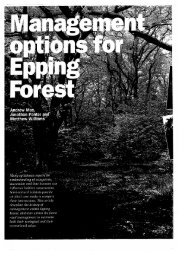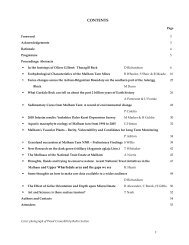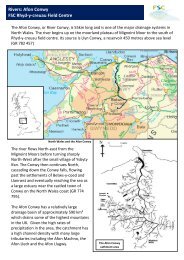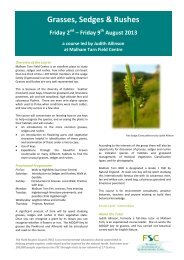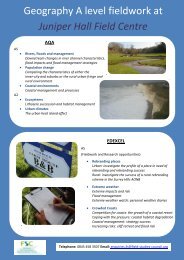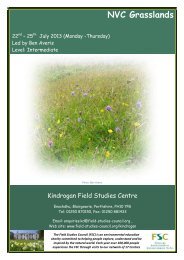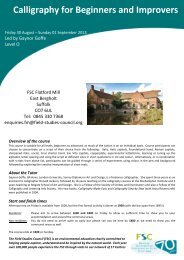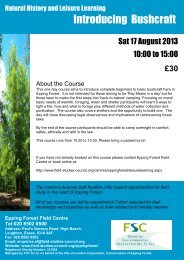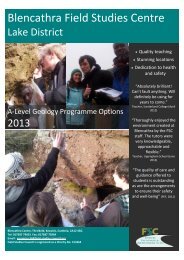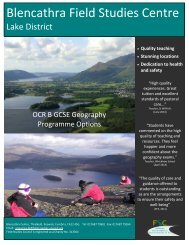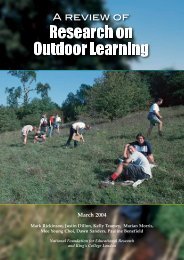newsletter - Slapton Ley National Nature Reserve
newsletter - Slapton Ley National Nature Reserve
newsletter - Slapton Ley National Nature Reserve
Create successful ePaper yourself
Turn your PDF publications into a flip-book with our unique Google optimized e-Paper software.
spring summer 2012<br />
Photography Saved! Events Herons <strong>Nature</strong> Trail<br />
www.slnnr.org.uk
Revival of Little Marsh<br />
H<br />
idden in the sanctuary area of the Higher <strong>Ley</strong>, the wetland<br />
area known as Little Marsh can be found, supporting a<br />
wide range of wildlife from birds, plants and an array of<br />
fascinating insects.<br />
Recently, the importance of this site has been emphasised<br />
through the arrival of the very rare Haworth’s minor moth,<br />
recorded in Devon only seven times. And Barrie Whitehall,<br />
who operates a moth trap in Little Marsh, has regularly<br />
recorded freshly emerged moths – their fresh condition<br />
would suggest that there is a breeding population in the<br />
marsh; a first for Devon. Over-wintering as eggs in leaf litter,<br />
caterpillars emerge and feed on the inside of soft rush, a<br />
plant found in the marsh.<br />
The marsh is also home to a<br />
very special and important<br />
assemblage of attractive<br />
wetland plants such as<br />
purple loosestrife, wild<br />
angelica and meadowsweet. A survey was conducted in<br />
May last year by Ros Bennett to assess the condition of Little<br />
Marsh. Ros noted that this was the last stronghold on the<br />
nature reserve of these important wetland plants. However,<br />
the natural processes of succession and sedimentation are<br />
changing the habitat, threatening the survival of its wildlife.<br />
Jim McPetrie farms the adjacent land. He recalled how the<br />
wetland plants once dominated a much larger part of Little<br />
Marsh. Traditionally, the marsh was cut for thatching<br />
material and grazed in the summer months by cattle.<br />
Removing this vegetation stopped any build-up of dead<br />
plant matter. However, in recent years the vegetation has not<br />
been harvested, allowing a dense layer of plant matter to<br />
form causing the marsh to dry out. As the ground has<br />
become firmer and drier, more aggressive terrestrial weeds<br />
such as nettles and brambles have been able to colonise and<br />
smother the wetland plants.<br />
The opportunity to control the aggressive weeds and restore<br />
the range of wetland plants has to be seized before it is too<br />
late. To achieve this, the land will be opened once again for<br />
grazing cattle, a conservation method which has been very<br />
successful in other regions. As a first step, large areas of scrub<br />
have already been removed through hard work from our<br />
volunteers, and fences installed to protect the boardwalk.<br />
Top: purple loosestrife • Brenda Child<br />
Above: the newly-fenced boardwalk.<br />
Left: meadowsweet • Brenda Child<br />
We look forward to the arrival of cattle into the marsh and<br />
will closely monitor the improvements made to this fragile<br />
environment.<br />
Photography tips<br />
I<br />
have been fortunate to run natural<br />
history photography courses for the<br />
FSC at <strong>Slapton</strong>*, in one of my favourite<br />
regions of the UK. With easy access to<br />
coastal, woodland, moorland and<br />
grassland habitats, the area offers huge<br />
potential for the nature photographer.<br />
poppy on the shingle ridge, or the<br />
lichens in <strong>Slapton</strong> churchyard. I use a<br />
wide angle lens for these shots, and go<br />
close to the main subject (sometimes<br />
just 150 mm or so), so that the habitat<br />
is clearly visible behind the specimen.<br />
a medium telephoto macro lens will<br />
come into its own – something like a<br />
100 mm macro lens will be perfect.<br />
Another subject for a telephoto lens<br />
are the many adders that inhabit the<br />
shingle ridge. These can often be found<br />
basking in the sun on warm days, but<br />
will quickly move off if they detect<br />
vibrations, so approach cautiously.<br />
Getting a general view of the reserve<br />
itself is tricky. There is a viewpoint<br />
behind the village of Torcross which<br />
overlooks the <strong>Ley</strong>, and another from<br />
the fields behind the Centre along the<br />
path beyond the farm. For general<br />
views like this lighting is critical, and<br />
is best either first thing in the morning<br />
or late afternoon.<br />
Adrian Davies<br />
2<br />
The reserve itself has a wonderful mix<br />
of habitats containing flowers and<br />
other plants, birds and mammals. It<br />
can be tempting to produce a series of<br />
portrait shots, but it is far more<br />
interesting to show the plants in their<br />
habitat, for example the long horned-<br />
The area abounds in insects – butterflies,<br />
moths and of course dragonflies. These<br />
can be very skittish, and we have spent<br />
many hours trying to photograph them,<br />
but occasionally you will find one that<br />
settles in a spot for a lengthy period<br />
allowing you to get close. This is where<br />
*See: www.field-studies-council.org/individuals-and-families/arts/photography
Start Bay Centre and<br />
<strong>Slapton</strong> <strong>Ley</strong> Field Centre join forces<br />
F<br />
or over 12 months the Start Bay Centre had been at risk of being closed as Devon<br />
County Council continue their search for ways to make savings. Understandably,<br />
the staff were worried about the future and the security of their jobs.<br />
At 2.22pm on 1st November the Field<br />
Studies Council (FSC, the education<br />
charity that owns <strong>Slapton</strong> <strong>Ley</strong> Field<br />
Centre) were able to secure a deal with<br />
Devon County Council and exchanged<br />
contracts. FSC became the new owners<br />
of the Start Bay Centre, securing the<br />
future of the Centre and all staff.<br />
The FSC are delighted to be involved<br />
with Start Bay Centre and to help keep<br />
the Centre open. As a charity we aim<br />
to give everyone the chance to be<br />
inspired by the environment so<br />
keeping facilities like Start Bay open is<br />
really important to us. Many other<br />
local authority centres across Britain<br />
remain under threat and may not<br />
achieve the same happy ending.<br />
<strong>Slapton</strong> <strong>Ley</strong> and Start Bay Centre have<br />
always worked well together with<br />
<strong>Slapton</strong> <strong>Ley</strong> offering opportunities for<br />
older A-level and University students<br />
from across Britain. Start Bay Centre<br />
offers opportunities for younger<br />
Primary School children in Devon and<br />
FSC want to maintain this provision<br />
for local children and schools.<br />
Our aim is to continue to operate<br />
both Centres in this vein within their<br />
complementary areas of expertise.<br />
As Start Bay Centre is located close to<br />
<strong>Slapton</strong> <strong>Ley</strong> Field Centre and the<br />
<strong>National</strong> <strong>Nature</strong> <strong>Reserve</strong>, it means the<br />
FSC are well placed to manage it and<br />
share resources.<br />
We hope that we can provide a new<br />
security for the Start Bay Centre for<br />
many years to come. The FSC has<br />
already started to invest in the Centre<br />
to update some of the bathroom and<br />
computer facilities. We are also<br />
actively encouraging more schools<br />
and groups from across Devon to use<br />
this amazing facility.<br />
If you know of a school or group<br />
that may want to stay in <strong>Slapton</strong> with<br />
fantastic views across Start Bay, please<br />
contact Andrew Pratt.<br />
Andrew Pratt<br />
Head of Centres<br />
Save our centres<br />
One in three Local Authority outdoor<br />
education centres are facing closure<br />
which could mean millions of young<br />
people are denied potentially lifechanging<br />
experiences, at a time when<br />
health, physical activity and contact<br />
with nature are all declining. Children<br />
from poorer and disadvantaged groups<br />
may not have another opportunity to<br />
share a night away from home and visit<br />
places they would not otherwise see.<br />
The fact is that closure need not happen<br />
– in many cases these centres could<br />
become self-sufficient if given time.<br />
You can help by signing a petition, set<br />
up by the FSC with the support of<br />
Association for Heads of Outdoor<br />
Education Centres, English Outdoor<br />
Council, Institute for Outdoor Learning<br />
and <strong>National</strong> Association of Field<br />
Studies Officers.<br />
To raise awareness of the campaign<br />
we have created a short piece of<br />
video which you can watch:<br />
http://youtu.be/WPEenciK8uQ<br />
Or to go direct to the petition visit<br />
http://epetitions.direct.gov.uk/<br />
petitions/26661<br />
Act now to protect these unique<br />
opportunities for young people.<br />
3
4<br />
Free...<br />
Events calender 2012<br />
Hedgerow Harvest<br />
Thursday 5th and Sunday 15th April, 10.30am–12.30pm<br />
Taste your way through <strong>Slapton</strong> <strong>Ley</strong> <strong>National</strong> <strong>Nature</strong> <strong>Reserve</strong> on a wild-food themed walk,<br />
searching for edible plants of the woodland, hedgerow and seashore.<br />
Meet at <strong>Slapton</strong> <strong>Ley</strong> Field Centre • Sensible outdoor clothing and footwear essential • Bring a basket<br />
Spring Stroll<br />
Saturday 21st April, 10.30am–12.30pm<br />
Enjoy the sights, sounds and smells of a woodland coming alive in spring. Discover hidden<br />
secrets and spectacular wildlife as you are guided through the sanctuary areas of <strong>Slapton</strong> <strong>Ley</strong>.<br />
Meet at <strong>Slapton</strong> <strong>Ley</strong> Field Centre • Sensible outdoor clothing and footwear essential<br />
Dawn Chorus<br />
Saturday 28th April, 6am–8am<br />
Listen to the sound of birds waking to a spring dawn on a quiet morning stroll around <strong>Slapton</strong><br />
<strong>Ley</strong>. Afterwards enjoy an optional breakfast of wholesome food.<br />
Meet at <strong>Slapton</strong> <strong>Ley</strong> Field Centre • Sensible outdoor clothing and footwear essential • Binoculars<br />
useful but not essential • Breakfast provided at £6 per person<br />
Birds of <strong>Slapton</strong> <strong>Ley</strong><br />
Saturday 5th, Monday 7th and Saturday 12th May, 10am–12 noon<br />
Discover the spring birds of <strong>Slapton</strong> <strong>Ley</strong> on a guided walk along the nature trail.<br />
Meet at <strong>Slapton</strong> <strong>Ley</strong> Field Centre • Sensible outdoor clothing and footwear essential<br />
• Binoculars useful but not essential<br />
Beach Clean<br />
Sunday 6th May, 10am–1pm<br />
Join us on <strong>Slapton</strong> Sands to help clean up our beautiful coastline.<br />
Meet in the middle car park on <strong>Slapton</strong> Sands (free parking) • Gardening gloves useful<br />
• Sensible outdoor clothing and footwear recommended<br />
Rocky Shore<br />
Monday 4th and Tuesday 5th June and<br />
Wednesday 1st, Thursday 2nd and Friday 3rd August, 10.30am–12.30pm<br />
Search for animals living in the rock pools of Torcross and learn what makes these creatures special.<br />
Meet at the <strong>Slapton</strong> <strong>Ley</strong> View Point in Torcross car park • Wellies recommended but can be hired<br />
if prior notice is given • I.D. guides will be available for purchase<br />
Bat Watch<br />
Wednesday 6th June and<br />
every Wednesday from 25th July–29th August, times vary with season<br />
Explore the night-time world of these magical creatures. Watch them emerge from their roosts,<br />
follow their foraging routes and use our bat detectors to hear their weird and wonderful calls.<br />
Meet at <strong>Slapton</strong> <strong>Ley</strong> Field Centre • Sensible outdoor clothing and footwear recommended<br />
• A torch and insect repellent are advisable<br />
Volunteer Celebration<br />
Thursday 7th June, 9am–12.30pm<br />
Supported by Natural eNglaNd HlS ScHeme<br />
Join us in the national Volunteers Week to celebrate the fantastic contribution of our dedicated<br />
volunteers. Enjoy a taste of working with our enthusiastic volunteers and experienced nature<br />
reserve staff and help perform vital conservation tasks around <strong>Slapton</strong> <strong>Ley</strong> <strong>National</strong> <strong>Nature</strong> <strong>Reserve</strong>.<br />
Meet at <strong>Slapton</strong> <strong>Ley</strong> Field Centre • Suitable outdoor clothing and footwear • Gardening gloves<br />
recommended • Tea and cake provided<br />
Beach Activities<br />
Weekends in July and everyday except Friday during the school summer holiday,<br />
12 noon–4pm<br />
Discover more about <strong>Slapton</strong> <strong>Ley</strong> <strong>National</strong> <strong>Nature</strong> <strong>Reserve</strong> with activities, crafts and trails at our<br />
Beach Trailer in the Memorial Car Park on <strong>Slapton</strong> Sands.<br />
Booking is essential for all events. For more information or to make a booking, call <strong>Slapton</strong> <strong>Ley</strong> Field Centre on 01548 581 529
Meet the Ranger<br />
Every Monday from 23rd July to 27th August, 2pm–4pm<br />
Join us for a stroll around <strong>Slapton</strong> <strong>Ley</strong> to explore the variety of wildlife found on the reserve and<br />
speak to the ranger who manages this wonderful area.<br />
Meet at the Beach Trailer • Sensible outdoor clothing and footwear recommended<br />
Life in the <strong>Ley</strong><br />
Every Tuesday from 24th July to 28th August, 2pm–4pm<br />
From scorpions to snails, or damsels to dragons, there are lots of exciting creatures to discover<br />
on a pond dip in <strong>Slapton</strong> <strong>Ley</strong>.<br />
Meet at the Beach Trailer • Wellies recommended but can be hired if prior notice is given<br />
• I.D. guides will be available for purchase<br />
Mysterious Minibeasts<br />
Every Wednesday from 25th July to 29th August, 2pm–4pm<br />
Lying under logs and hiding in bushes, minibeasts can be found all around the nature reserve.<br />
Join us on an adventure to discover as many minibeasts as we can.<br />
Meet at the Beach Trailer • Sensible outdoor clothing and footwear • I.D. guides will be available<br />
for purchase<br />
Secretive Dormice<br />
Thursday 26th July and 23rd August, 10am–12 noon<br />
Discover more about one of our most elusive mammals and hopefully catch a glimpse of one on<br />
an adventure around the nature reserve.<br />
Meet at the Beach Trailer • Long trousers and sensible footwear are essential<br />
Bird in the Hand<br />
Saturday 28th July and Sunday 26th August, 8.00am–10am<br />
Get up close and personal with some of our feathered friends by viewing the bird-ringing<br />
operation manned by the Devon Bird Watching & Preservation Society. Then join us on a walk<br />
through a sanctuary area to watch these birds in flight.<br />
Meet at <strong>Slapton</strong> <strong>Ley</strong> Field Centre • Sensible outdoor clothing and footwear recommended<br />
• Binoculars useful but not essential<br />
Bushcraft<br />
Wednesday 1st, 8th and 15th August, 10am–12 noon<br />
Test your survival skills as you learn how to light fires and build shelters on a walk around <strong>Slapton</strong> <strong>Ley</strong>.<br />
Meet at <strong>Slapton</strong> <strong>Ley</strong> Field Centre • Sensible outdoor clothing and footwear<br />
Celebrate Start Bay<br />
Saturday 18th August, 10am–4pm<br />
A day-long celebration of ‘all that is good’ about the Start Bay area showcasing local arts and<br />
crafts, food and the great outdoors. Plus a full programme of outdoor and indoor activities and<br />
entertainment, talks and workshops.<br />
Contact <strong>Slapton</strong> <strong>Ley</strong> Field Centre for more details<br />
<strong>Slapton</strong> Summer Safari<br />
Monday 30th July –Friday 3rd August, 9.30am–3pm<br />
<strong>Slapton</strong> Summer Safari promises to be a wonderful week of adventure and discovery helping<br />
young people learn more about their local area and the amazing plants and animals that live<br />
there. Each day the group will explore new sites in and around the <strong>Slapton</strong> <strong>Ley</strong> <strong>National</strong><br />
<strong>Nature</strong> <strong>Reserve</strong>.<br />
Meet at <strong>Slapton</strong> <strong>Ley</strong> Field Centre • £17.50 per child per day (£80 for whole week – family<br />
discounts available) • Contact <strong>Slapton</strong> <strong>Ley</strong> Field Centre for more details<br />
Wildlife Canoe Tour<br />
Every Thursday in August<br />
Join us for a rare opportunity to experience <strong>Slapton</strong> <strong>Ley</strong> from a unique perspective. You will be<br />
taken on a two-hour educational canoe trip on the <strong>Ley</strong>, learning about its diverse wildlife and<br />
rich history along the way.<br />
Morning (6-8am, 8.30-10.30am and 11am-1pm) and afternoon (12-2pm, 2.30-4.30pm and 5-7pm)<br />
sessions run on alternate weeks (call for more details) • Meet at <strong>Slapton</strong> Bridge • £20 per<br />
person • Wear appropriate clothing and footwear (you may get cold and wet!) and bring a<br />
change of clothes • Bring sun cream, hat and a drink<br />
Booking is essential for all events. For more information or to make a booking, call <strong>Slapton</strong> <strong>Ley</strong> Field Centre on 01548 581 529<br />
5
Bluebell<br />
Helping our native woodland wildlife<br />
A<br />
pproached from the north along a boardwalk from the Ireland Bay reed beds,<br />
France Wood is a semi-natural woodland in a quiet sanctuary area at the<br />
southern end of the nature reserve. We are working hard to stop the spread of<br />
sycamore trees for the future benefit of our native wildlife.<br />
Ash, beech, cherry, oak and sweet<br />
chestnut are the main native trees in<br />
France Wood. More recently there has<br />
been a dramatic increase in sycamore.<br />
<strong>National</strong>ly there is debate on just what<br />
value sycamore has to ecosystems, but<br />
our research suggests that it only<br />
supports a relatively small range of<br />
species. Its rapid growth rate and dense<br />
canopy inhibits the regeneration of other<br />
tree species. The dense leaf litter and<br />
sticky nature of their fallen leaves may<br />
have a detrimental effect on ground flora.<br />
Although its biodiversity is less rich than <strong>Slapton</strong> Wood, it does support some<br />
important species. In Spring the woodland floor comes alive in the spring with<br />
carpets of native bluebells and ramsons, and the hazel understorey provides a perfect<br />
habitat for the dormouse. There is a small population of roe deer. Buzzard, great<br />
spotted woodpecker, nuthatch, sparrowhawk, tawny owl, and<br />
treecreeper number among the regular breeding bird species.<br />
Our 100 Year Plan for France Wood is to stop the spread of<br />
sycamore. We have divided the wood into 100 zones, recorded<br />
sycamore trees in each and fell the sycamore section<br />
by section every year. Because trees live for hundreds<br />
of years woodland management should be planned with<br />
a long term version. Surveys in other woodlands following<br />
sycamore control programmes have shown a significant<br />
increase in biodiversity, and we hope to be able to report the same<br />
for France Wood in years to come.<br />
Join one of our events Spring Stroll or Meet the Ranger for an opportunity to explore this quiet<br />
area of the nature reserve (see pages 4 and 5).<br />
Sycamore leaf<br />
Batty <strong>Slapton</strong><br />
Which nocturnal creature can weigh<br />
less than a pound coin, eat 3000<br />
insects in one night and finds it way<br />
around by listening for echoes The<br />
answer: the humble bat!<br />
These amazing animals are the only<br />
mammals that can truly fly. We are<br />
lucky to have 12 species of bats<br />
recorded around <strong>Slapton</strong> <strong>Ley</strong> (17<br />
species breed in Britain), so the nature<br />
reserve is a great place to visit at dusk<br />
as you are likely to see bat activity.<br />
But the reserve isn’t the only place to see<br />
bats. The Field Centre in <strong>Slapton</strong> village<br />
houses bats as well as students, with a<br />
maternity roost for pipistrelle bats –<br />
Britain’s most common species – in the<br />
roof of one of the buildings. There is also<br />
an overflow roost for lesser horseshoe<br />
bats, a quite rare species found only in<br />
the west of England and Wales.<br />
The lesser horseshoe roosts are<br />
monitored by volunteers as part of the<br />
<strong>National</strong> Bat Monitoring Programme.<br />
By counting the number of bats that<br />
emerge from the roost on summer<br />
evenings we can discern trends in<br />
British bat populations. In 2011 the<br />
<strong>Slapton</strong> roost was the 32nd largest<br />
colony of lesser horseshoe bats out of<br />
91 monitored across the country, with<br />
a peak count in June of 141 bats.<br />
Maryanne Wills<br />
Come and join our Bat Watch event to<br />
discover more (see page 4).<br />
6<br />
Great Reed Warbler<br />
<strong>Slapton</strong> <strong>Ley</strong> Research<br />
Seminar 2012<br />
F<br />
or over 50 years, the mosaic of<br />
habitats found at <strong>Slapton</strong> <strong>Ley</strong> NNR<br />
has been the focus of research carried<br />
out by universities, professionals and<br />
enthusiasts. The annual research<br />
seminar is excellent way to share this<br />
knowledge to a wider audience.<br />
Chaired by Dr David Stradling,<br />
Chairman of the Whitley Wildlife<br />
Conservation Trust, this years event saw<br />
a fantastic turnout of 70 attendees all<br />
looking forward to a diverse range of<br />
informative talks, ranging from a report<br />
from the Bird Observatory Ringing<br />
Group to a discussion on the potential<br />
changes to habitats and species in the<br />
event of a breach in <strong>Slapton</strong> Line.<br />
Although numbers of roosting swallows<br />
reached up to 100,000 in a single night<br />
last year, Dennis Elphick of the Devon<br />
Palmer Dam<br />
Bird Watching and Preservation<br />
Society gave a revealing talk on how<br />
this roost may be in decline.<br />
Dr Tim Kurz and Prof Patrick Devine-<br />
Wright, Exeter University, have been<br />
examining community perceptions of<br />
coastal change around <strong>Slapton</strong> Line.<br />
This pilot project involved<br />
interviewing a variety of local<br />
residents. Many questions were raised<br />
as to the cause of environmental<br />
changes as well as the roles and<br />
motives of scientists.<br />
Many thanks to all the speakers and<br />
guest who made this a successful<br />
event. If you would like to discuss the<br />
possibility of carrying out research at<br />
<strong>Slapton</strong> <strong>Ley</strong>, please contact Andrew<br />
Pratt, enquiries.sl@field-studiescouncil.org.<br />
To find out more about the research<br />
undertaken at <strong>Slapton</strong> <strong>Ley</strong>, visit our updated<br />
website www.slnnr.org.uk.
Grey Heron • Howard Bottrell Clouded Yellow • Brenda Child<br />
Walking with butterflies<br />
I<br />
f you have ever walked the <strong>Nature</strong><br />
Trail in <strong>Slapton</strong>, or just sat in a field in<br />
the summer, you will probably have had<br />
an encounter with a butterfly or two.<br />
In order to find out which butterflies<br />
were in the local area a weekly survey<br />
was carried out in the fields on the north<br />
side of <strong>Slapton</strong> Wood, an area known<br />
as Loworthy fields, from the beginning<br />
of April to the end of September.<br />
Providing the weather was suitable,<br />
we walked along the seven connecting<br />
pathways (or transects) and any<br />
butterflies that fluttered by were<br />
recorded. (They are best identified<br />
while in flight rather than catching<br />
them; if luck is with you, you may<br />
have a minute to identify it while the<br />
butterfly is resting on a plant.)<br />
The survey followed guidelines set by<br />
the UK Butterfly Monitoring Scheme<br />
and the results fed into a national<br />
database. The information can give<br />
<strong>Slapton</strong> <strong>Ley</strong><br />
heronry<br />
insight into the population of different<br />
butterfly species. Butterflies can also be<br />
used as indicators of the environment<br />
and climate change as they have a<br />
rapid life cycle and are sensitive to<br />
environmental conditions. We hope to<br />
continue monitoring the butterflies<br />
and build up a long term set of data.<br />
During the summer of 2011 (20 weeks), a<br />
total of 838 butterflies were counted. The<br />
most common butterfly was the meadow<br />
brown, with peak numbers reaching<br />
93 in July. Other frequently spotted<br />
butterflies included the gatekeeper,<br />
orange-tip, small white and common<br />
blue. Rarities to Loworthy fields were<br />
the brimstone and clouded yellow.<br />
There is another glade along the <strong>Nature</strong><br />
Trail which is a great place to sit and<br />
watch butterflies in the summer and has<br />
a useful identification board. Why not<br />
pay a visit and see how many you spot<br />
Gemma Langworthy<br />
T<br />
Painted Lady • Brenda Child<br />
‘V’ is for Volunteer<br />
It’s incredible what a difference a year makes.<br />
This time last year I was in London, sitting at<br />
my desk, stressed to the eyeballs. I’d never<br />
worked outside, never used ‘industrial’<br />
gardening tools, and would never be seen in<br />
steel capped boots. Dormouse Survey anyone<br />
Um... what’s that However since I moved to<br />
Devon, and became a volunteer at <strong>Slapton</strong><br />
<strong>Ley</strong> <strong>Nature</strong> <strong>Reserve</strong>, this has all changed.<br />
It came as a bit of a<br />
surprise to discover<br />
that not only can I do<br />
all those things – I<br />
actually love doing<br />
them. In fact I often<br />
don’t want to go<br />
home and would quite<br />
happily stay on into<br />
the night, cutting<br />
through ivy growing<br />
up tree trunks (it acts<br />
as ‘sails’ on the trees<br />
and can pull them down in high winds).<br />
Now I know what it feels like to stand in the<br />
rain with a pair of loppers, to hear the<br />
distant rustle of tree tops when you’re deep<br />
in the forest, to laugh out loud at the<br />
bumpiness of the Land Rover and to<br />
breathe air so clean it makes you feel like a<br />
new person inside. And one day, if I’m very<br />
lucky, I might even get to see a dormouse.<br />
Hariet Lake<br />
he grey heron is arguably one of the most impressive birds to grace the wetland<br />
habitats of <strong>Slapton</strong> <strong>Ley</strong>. In flight it displays a highly distinctive profile: the<br />
strongly bowed wings spanning up to 185 cm, its neck retracted and those long legs<br />
trailing in its wake.<br />
When feeding at the water’s edge the bird adopts an almost statuesque one-legged<br />
pose, remaining motionless until ready to unleash that deadly dagger-like bill on<br />
its unsuspecting prey, preferentially taking fish, but with amphibians, small<br />
mammals and young birds very much on the menu.<br />
The heron’s nest comprises a large basket of sticks and twigs, perched high in the<br />
canopy of mature waterside trees The small yet well established colony at <strong>Slapton</strong><br />
<strong>Ley</strong> numbers some 3 to 5 breeding pairs. Herons are early breeders, with the birds<br />
gathering in February, when they assemble on the old nesting platforms to<br />
undertake elaborate courtship displays, running and skipping in one direction<br />
then the next, wings spread wide with crest and neck plumes erect, those massive<br />
bills now a deep orange in colour. An average of 3 or 4 eggs are laid, hatching after<br />
some 27 days with the young fledging about 7 weeks later.<br />
Perhaps the most immediate threat to the <strong>Slapton</strong> birds is the dramatic impact that<br />
disturbance can have on their breeding programme. The woodland surrounding<br />
the <strong>Slapton</strong> heronry is managed as a sanctuary area to manage access during the<br />
breeding season. The only notable breeding failure in recent years is believed to be<br />
attributable to disturbance caused by errant dog walkers, when unauthorised<br />
access to the woodland appeared to drive the birds from their nests, leaving the<br />
eggs temporarily exposed. The ravens nesting on the far side of the wood were<br />
probably the beneficiaries of these actions!<br />
The best vantage point (binoculars essential) for viewing the heronry is probably<br />
from the shingle ridge at a position some 400 metres south of the Memorial car<br />
park. Looking inland across the <strong>Ley</strong> there is a small plantation along the western<br />
shore of the <strong>Ley</strong> where these impressive birds may be seen in the tree canopy.<br />
7
<strong>Slapton</strong> <strong>Ley</strong> <strong>Nature</strong> Trail<br />
T<br />
he coastline at <strong>Slapton</strong> is a special place. The great skies, changing each minute,<br />
and the huge seas, changing with every tide, are mesmerising.<br />
Visitors come year after year to see<br />
this Devon landscape and seascape,<br />
knowing that it is unique. Above all,<br />
there is a long ridge of shingle here<br />
which divides the sea from the<br />
freshwater lakes, or ‘leys’.<br />
It is this shingle ridge which provides<br />
an unusual habitat. Salt spray, harsh<br />
winds and thin soil make this a difficult<br />
place to survive. Yet the shingle ridge<br />
is where distinctive flowers have<br />
learnt to live: yellow horned-poppy,<br />
sea pink and sea spurge are just a few.<br />
The reedbeds provide more shelter.<br />
This is where you will find plants that<br />
have adapted to wet conditions. Stately<br />
yellow flags can be found amongst the<br />
reeds and tiny pairs of blue skullcap<br />
flowers at the water’s edge. Close by,<br />
woodland plants have found a home in<br />
the semi-shade under the trees. Here’s<br />
where, in spring, bluebells create a<br />
patchwork of colour with red campion<br />
and bright-white stitchwort.<br />
Enjoy a stroll around our nature trail and<br />
look out for our top ten favourite plants.<br />
The plants<br />
Clockwise,<br />
from right:<br />
bluebell;<br />
dog violet;<br />
red campion;<br />
vipers bugloss;<br />
thrift; sea kale;<br />
yellow horned-poppy;<br />
yellow flag;<br />
skullcap;<br />
sweet violet.<br />
P<br />
P<br />
<strong>Slapton</strong><br />
Brenda Child<br />
Field<br />
Centre<br />
P<br />
P<br />
P<br />
Little<br />
Marsh<br />
<strong>Slapton</strong><br />
Bridge<br />
P<br />
P<br />
P<br />
P<br />
P<br />
France<br />
Wood<br />
P<br />
<strong>Slapton</strong> <strong>Ley</strong> walks and trails<br />
Explore three waymarked trails and the South West Coast Path<br />
Family trail: 1.5 miles – approximately 45 minutes<br />
Village trail: 1.75 miles – approximately 1 hour<br />
Valley trail: 2.5 miles – approximately 1.5 hours<br />
South West Coast Path<br />
These trails provide easy walking with some steps. The viewing<br />
platform at <strong>Slapton</strong> Bridge provides access for all.<br />
P<br />
P<br />
P<br />
Facilities Memorial Car Park: parking and toilets<br />
<strong>Slapton</strong> Bridge: parking and viewing platform with access<br />
<strong>Slapton</strong> and Torcross: shops and pubs<br />
<strong>Slapton</strong> <strong>Ley</strong> <strong>National</strong> <strong>Nature</strong> <strong>Reserve</strong> (NNR)<br />
is owned by Whitley Wildlife Conservation<br />
Trust and managed by the Field Studies<br />
Council’s (FSC) <strong>Slapton</strong> <strong>Ley</strong> Field Centre.<br />
Head of Centre: Andy Pratt.<br />
in partnership with:<br />
SLAPTON LEY<br />
FIELD CENTRE & NATIONAL NATURE RESERVE<br />
8<br />
<strong>Reserve</strong> Manager: Nick Binnie.<br />
South Hams<br />
District Council



